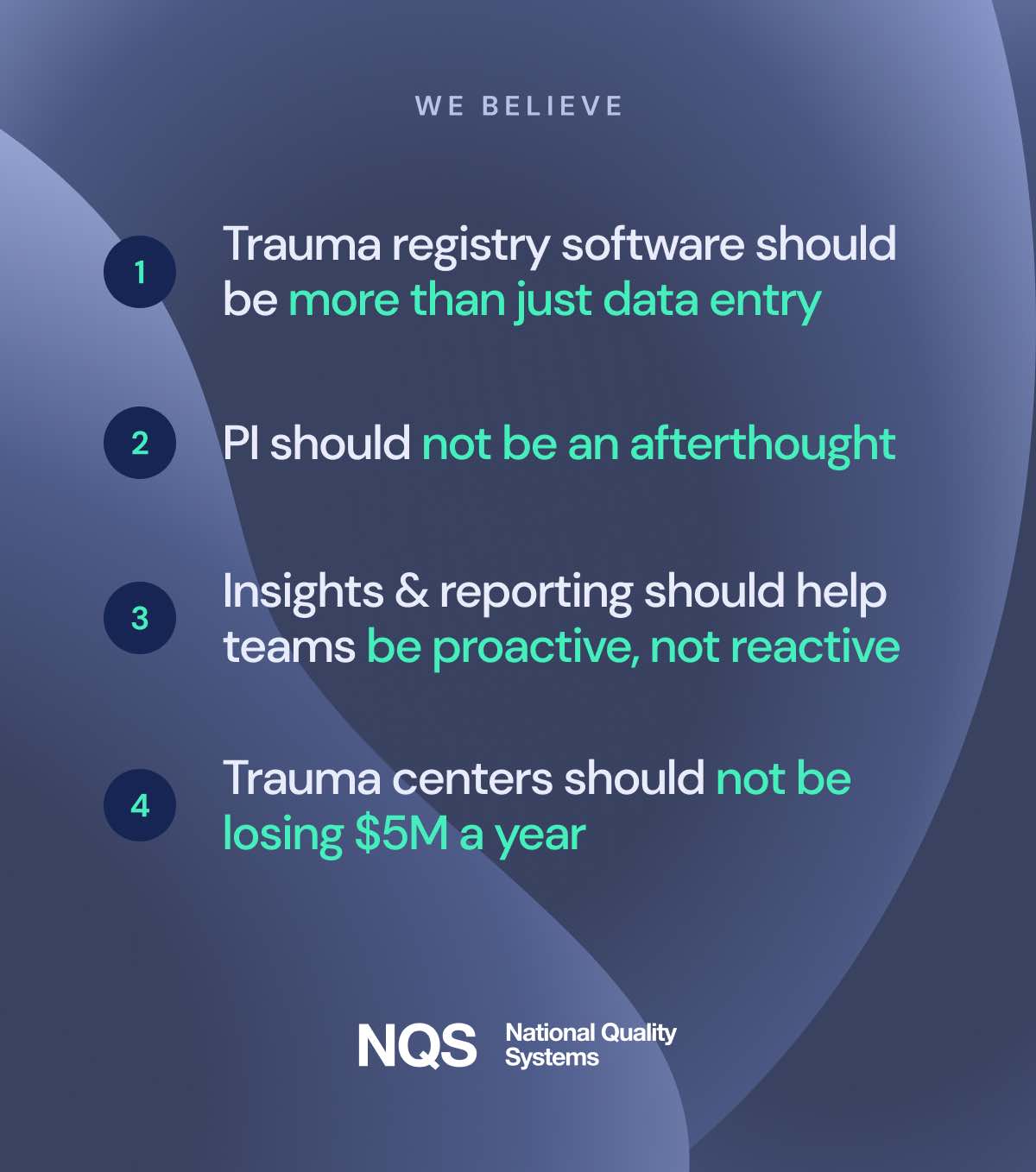

Every trauma program wants to be great at turning data insights into lasting performance improvements. But they are currently shackled with outdated tools that force teams to spend more time on data entry and less time making impactful decisions. We believe there is a better way…
The Goal
We share the ACS’ belief that trauma program’s should strive to eliminate preventable death and disability from injury.
And to achieve this, trauma teams must have all the data, tools and processes that empower them to improve patient outcomes.
But how can we get there?
Let’s first take a hard look at where we are now.
The Current Way is Out of Date
Current trauma registry software vendors do not prioritize trauma teams. These software conglomerates (and they are conglomerates of multiple software companies) are first and foremost pre-hospital EMS systems. And their near-monopolistic status has meant they could continue to treat trauma customers as secondary or more, not caring to put resources to significant trauma innovation for decades.
And this is why these tools have remained primarily data entry repositories to this day. You put data in. And send that data off.
Yes you can run reports, but you need other formats and other tools to get any insight from them.
And isn’t getting performance-enhancing insights from your data the core reason to go through this process?
Trauma professionals are frustrated. They use friendly, insightful software in other areas of their lives. But not with registry software.
Why should this be any different?
We agree.
What this Means for Trauma Teams
The legacy software industry only offers the absolute bare, required minimum for trauma teams. The cost of this disinterest is significant, impacting everyone involved, from the trauma team to patients.
Trauma teams are overworked
Registrars and PI coordinators are stretched thin, overwhelmed with cases and hindered by inefficient tools that require too much laborious data entry and data extraction. This leaves little time for the critical work that can drive real change. It can feel like you don’t have the support you need.
Managers struggle as well, seeing their teams overburdened and morale suffering as a result.
Difficult to hire and retain team
Outdated software contributes to a challenging work environment that makes hiring and keeping a strong, happy team difficult. We’re seeing a trend of otherwise qualified staff simply leaving the profession. How much of this is due to the monotonous, manual nature of this work?
For trauma program managers, this means facing high costs and difficulties in recruiting and retaining experienced registrars and PI coordinators.
Trauma center performance suffers
Outdated software leads to a reactive stance at trauma centers, as teams struggle to extract timely, meaningful insights from old data.
Taken to the extreme, an overly reactive approach risks performance – and even accreditation – loss, costing millions and potentially harming hospitals’ standing in the community.
Without the ability to act on data proactively, trauma program managers, registrars, PI coordinators and others on the trauma team are constantly dealing with data emergencies instead of preventing them before they become issues.
Revenue is lost
Clinical performance is not the only type of performance that teams need accurate insights into. We see an average $5M in lost charges in trauma centers across the US.
This perpetuates the cycle further. Less resources. Less staff. Less helpful tools. Less proactive. More reactive. More stress.
We Believe There’s a Better Way
We believe that in order to eliminate preventable death and disability from injury, trauma programs need more than a basic data repository.
They need modern tools that unlock their entire teams to do their best work.
We aim to be the most advanced trauma platform designed to help Surgeons, TPMs, Registrars, PI Coordinators and Injury Prevention Coordinator be their most effective selves.
5 Key Elements to Transform How Trauma Teams Do their Best Work

1. Trauma registry software should be a partner to registrars
Trauma registries should not just be data entry repositories. They should empower registrars to make better decisions. Whether that’s by helping make related source information more accessible, giving guidance for decisions or helping manage their day-to-day work, registrars should be able to focus more on what they do best while supervised software takes care of the rest.
2. PI should not be an afterthought
Current software options treat performance improvement as an afterthought. We believe this is completely backwards. Performance Improvement is essential to trauma teams, not a “nice to have.” We believe software should help PI Coordinators do what they do best: actively help their teams improve patient outcomes, not spend all of their time on data entry. Modern software can help PI coordinators with timelines, complications, PI meetings and workload management.
3. Be proactive, not reactive
We believe data – and gaining understanding from that data – should be as quick as possible. Running one-time reports and exporting them into other formats and tools leads to teams acting on old data and wasted time. We believe in quickly accessible insight views built specifically for TPMs, PI Coordinators, Registrars and Injury Prevention Teams. We believe in getting answers to questions quickly.
4. Trauma centers should not be losing $5M a year
Based on the financial assessments we’ve performed at dozens of trauma centers, the average facility is missing out on $5M per year of lost charges. This means that the average trauma team is delivering services that are not being charged. We believe that every trauma program should be generating the revenue that their hard work is worth. We believe that when trauma programs reclaim their significant, correct resources, they can help more people in their communities.
Our Promise
Our journey to reshape trauma programs begins with a simple belief: empowerment leads to excellence. By liberating teams from outdated systems, we promise to pave the way for meaningful and sustained improvement in trauma care.
Empower Your Team
Join us on LInkedIn, sign up for early access or contact us if you’d like to join us on this mission to empower your full trauma care team, elevate team performance and drive meaningful improvements in patient outcomes.



